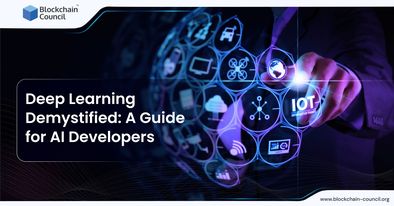Deep learning emerges as a formidable and paradigm-busting entity within the expansive domain of artificial intelligence (AI). As the sophistication of AI applications increases, there is a growing need for AI developers with a comprehensive understanding of deep learning principles. This guide aims to elucidate the complexities of deep learning, furnishing AI developers with an all-encompassing comprehension of its technical subtleties. Furthermore, an examination will be conducted on the importance of AI certifications, including AI Expert Certification and AI Developer Certification, in substantiating and augmenting proficiency in deep learning.
Fundamentals of Deep Learning
Fundamentally, deep learning constitutes a subfield within machine learning that centres on multi-layered or deep neural networks. These networks are constructed with layers of interconnected nodes, or neurons, which process and analyse data in a manner reminiscent of the human brain. Due to their capacity to acquire complex representations and patterns from enormous datasets, these networks are proficient at speech recognition, natural language processing, and image recognition.
Fundamental Elements of Deep Learning
Neural networks serve as the foundational architecture of deep learning models. These networks are composed of an input layer, concealed layers, and an output layer. They utilise interconnected nodes to process and transform input data into meaningful outputs—the capacity of neural networks to discern intricate patterns in data results from their profundity and complexity.
Activation functions facilitate the acquisition of intricate data relationships by imbuing the neural network with non-linearity. Constantly utilised activation functions include the sigmoid, tanh, and Rectified Linear Unit. The activation function selected has a significant impact on the efficacy and training rate of the model.
Backpropagation, an essential algorithm in deep learning, is tasked with modifying the model weights in response to the discrepancy between the predicted and actual outputs. Through this iterative refinement process, the neural network’s efficacy gradually improves.
Loss Functions, The discrepancy between predicted and actual outputs is quantified by loss functions. Determining a suitable loss function is contingent upon the characteristics of the undertaking, be it regression, classification, or another distinct application.
Training and Optimisation, During the training phase, deep learning models acquire knowledge by analysing annotated data. Optimisation algorithms are utilised iteratively to modify the model’s parameters, including stochastic gradient descent (SGD) and Adam, to improve the accuracy of predictions and minimise the loss function.
AI Certifications: Verification of Proficiency in Deep Learning
In light of the increasing need for deep learning proficiency, AI certifications have emerged as highly esteemed credentials among AI developers. AI certifications, such as the AI Developer Certification and the AI Expert Certification, are intended to attest to a professional’s competence in numerous facets of artificial intelligence, focusing specifically on deep learning.
What is certification in AI?
A formal acknowledgement of an individual’s proficiency in artificial intelligence constitutes AI certification. Demonstrating proficiency in the design, implementation, and optimisation of AI systems is precisely what it entails. AI certifications encompass a wide array of subjects, including fundamental AI principles and sophisticated methodologies, guaranteeing that individuals with such credentials are adequately prepared to navigate the intricacies of deep learning.
Exam for AI Certification: An Evaluation of Deep Learning Expertise
The AI certification examination serves as the ultimate benchmark in the certification procedure, evaluating an individual’s comprehension and expertise in the fundamentals of deep learning. The exhaustive examination generally comprises theoretical inquiries, practical situations, and problem-solving assignments, all assessing a developer’s proficiency in applying deep learning principles to tangible obstacles.
Conversational AI and Deep Learning
An instance of deep learning in artificial intelligence being utilised extensively is the creation of intelligent avatars. These AI avatars can conduct substantive dialogues with users using deep learning algorithms and natural language processing. Incorporating deep learning enables chatbots to comprehend context, identify sentiment, and engage in interactions that more closely resemble humans.
Expert Certified Chatbot: Conversational AI Mastery
Acquiring certification as an expert in chatbots requires an in-depth study of the technical facets of conversational AI. A certified chatbot expert, in contrast to AI certifications (e.g., AI Developer Certification), which provide a fundamental understanding of deep learning, possesses specialised knowledge regarding the intricacies of chatbot development, including dialogue management, language comprehension, and user experience.
An Examination of the Technical Intricacies of Deep Learning
Convolutional Neural Networks (CNNs), are a subset of deep neural networks specifically engineered to analyse videos and images. By utilising convolutional layers, they autonomously acquire hierarchical representations of visual data, which enables them to perform tasks such as object detection and image classification with notable efficacy.
Recurrent Neural Networks (RNNs), are highly suitable for time-series analysis and natural language processing because they can process sequential data. Their capacity to encapsulate dependencies and context within sequences facilitates a more https://techsponsored.com/intricate comprehension of temporal patterns.
Transfer learning, is an approach that optimises pre-trained models for particular tasks by utilising them on extensive datasets. By substantially diminishing the requirement for copious amounts of annotated data and computational resources, this methodology is a pragmatic resolution for many practical applications.
Generative Adversarial Networks (GANs), are composed of discriminators, generators, and neural networks that engage in competitive learning. GANs are highly effective at producing new content, image-to-image translation, and generating plausible synthetic data.
Conclusion
With its pivotal role in driving progress across various domains, deep learning has emerged as a crucial cornerstone in the ever-evolving realm of AI development. Developers of artificial intelligence who wish to conquer the complexities of deep learning can benefit significantly from obtaining AI certifications. By attaining certifications such as AI Developer Certification and AI Expert Certification or specialising in the certification of chatbot experts, individuals demonstrate their expertise in deep learning and establish a systematic route to technical prowess. In the evolution of artificial intelligence, the contributions of certified AI professionals are crucial in fostering innovation and expanding the limits of what AI systems can accomplish.

